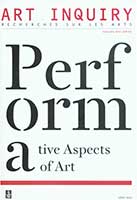Tadeusz Kantor: his performing art and the memory of the Holocaust
Tadeusz Kantor: his performing art and the memory of the Holocaust
Author(s): Eleonora JedlińskaSubject(s): Fine Arts / Performing Arts
Published by: Łódzkie Towarzystwo Naukowe
Keywords: Holocaust; Jews; memory; theater; performance; music; song; literature; paintings; object; tradition; history; tale; melancholy; sarcasm
Summary/Abstract: Kantor made use of archival materials, photographs as well as historical and commemorative relics in his artistic undertakings (painting, theater, happening, scores). Staying in a close relationship with painting and theater, using music/sounds, reaching for literary sources and documents, hearsay stories, and finally his own nightmares and memory, he created “performative situations”. Therefore, from the point of view of the idea of performativity we can interpret Kantor’s works through an interdisciplinary perspective of research into various phenomena of social and cultural life: history, memory, literature, art, and past experience. In this paper I will be interested in the elements from which he created his art. What seems to be crucial from this perspective is the display and reception of Kantor’s works in Nuremberg in 1996 and – along with the works of Joseph Beuys – in Jerusalem (an exhibition titled Beuys| Kantor. Remembering) in 2012. The places of the exhibitions (Nuremberg, Jerusalem) resulted in the perception of Kantor’s creations as strongly connected with the memory of the Holocaust. The memory of the extermination was constantly present in his paintings and plays, in which he questioned the boundaries of what is theatrical, pictorial, or inseparable from history and memory. The discussion of performativity in Kantor’s creations includes the question of its possible limit, which, according to the artist, results from memory. Kantor understood that the traumatic character of the memory of “the times of war and lords of the world” must make an artist revise the conventions of performance worked out in the past. The new poetics frequently amounted to a readiness to cross the borderline set by such notions as mimesis, illusion, realness and performance. An artist who creates in post-Holocaust times must use his art to commemorate the people and events that he witnessed. The motives which relate the Jewish tradition in Poland to the memory of the Holocaust are present in Kantor’s art through suggestive paintings, objects, figures and signs which are to be found in his “Cricot 2 Theater”. On the one hand his use of music, singing, significant objects, certain paintings and sketches situates Kantor’s achievements within the field of research into the role of performatics in current discussions about his art, and on the other it allows us to categorize him as a performative artist. With his art Kantor transgresses the melancholic idea of trauma and provokes the individual to engage in mourning understood as a social performance.
Journal: Art Inquiry
- Issue Year: 2012
- Issue No: 14
- Page Range: 93-118
- Page Count: 26
- Language: English

